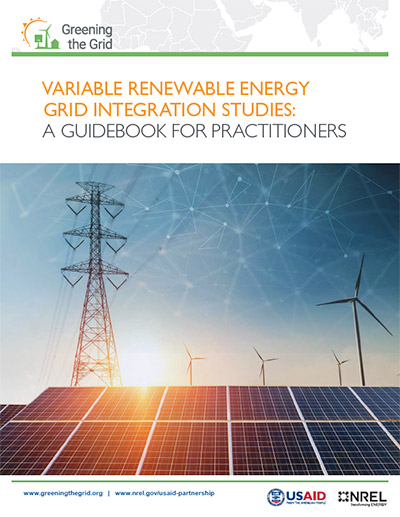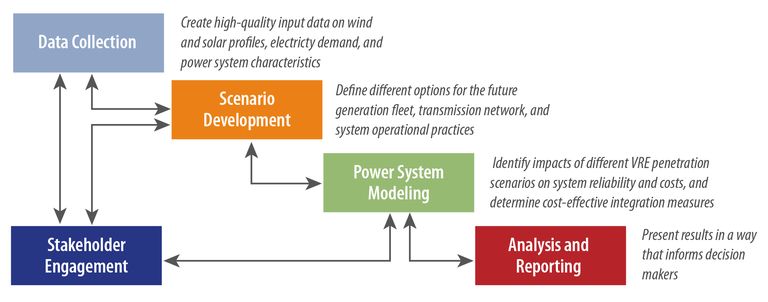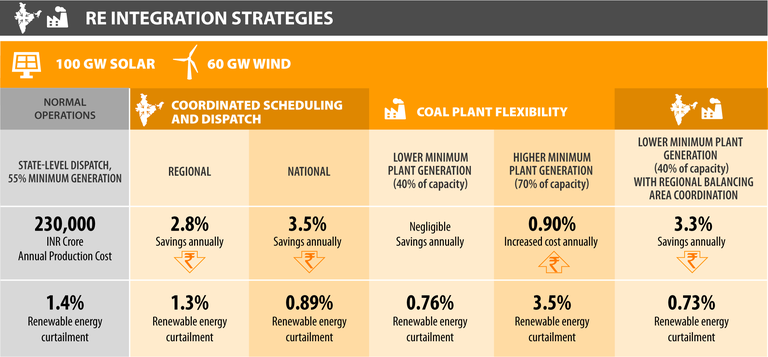Components of a Grid Integration Study
Conducting a grid integration study involves several iterative activities, as illustrated in Figure 2. There are five main components of a grid integration study: (1) stakeholder engagement, (2) data collection, (3) scenario development, (4) power system modeling, and (5) analysis and reporting.
Stakeholder Engagement
Engaging a diverse group of stakeholders in a grid integration study can contribute to a comprehensive, relevant, and actionable planning process that reflects the concerns of both industry and policymakers. Key stakeholders involved in a grid integration study include government agencies, power system operators, electricity regulators, utilities, transmission providers, data providers, renewable energy plant operators and developers, academic researchers, and public advocates.
The two main mechanisms for engaging stakeholders in a grid integration study are technical review committees (TRCs) and modeling working groups (MWGs). A TRC is a group of decision makers from various organizations that provide rigorous peer review, expert technical expertise, and direction throughout a grid integration study. Specifically, a TRC helps to link industry and policy concerns to deepen the understanding of high-penetration renewable energy issues and solutions. A TRC comprises policymakers, power sector regulators, operators, VRE and conventional plant owners, utilities, environmental and public advocates, and technical experts. On the other hand, an MWG is a technical team that conducts analytical and modeling activities for a grid integration study. An MWG typically comprises technical staff from the power system operator, policy institutions, and other organizations with expertise in power systems, electrical engineering, power flow modeling, and the mechanisms that drive electricity operations and markets.
To build a stakeholder-driven grid integration study, the study leadership team can determine which organizations should be represented in the TRC and MWG, facilitate TRC and MWG meetings, and establish transparent lines of communication and documentation processes for both the TRC and MWG.
Quick references on establishing a stakeholder-driven process can be found in the original guidebook.
Data Collection
To conduct a robust grid integration study, it is crucial to obtain high-quality data, which involves developing wind and solar resource profiles. At a minimum, grid integration analyses require one year of renewable energy resource data for locations under consideration for wind or solar generation. High spatial and temporal resolutions can capture the variability of wind and solar generation and facilitate modeling integration impacts and solutions. For example, high-spatial-resolution data can enable a grid integration study to demonstrate the benefits of the geographic diversity of solar and wind resources. Accurate system data on electricity generation, demand, and transmission grid characteristics are also essential for model development. Data collection might require a substantial time investment, so it is important to ensure that data collection begins well in advance of modeling activities. Data for a grid integration study can come from various sources, such as system operators, energy ministries, electricity regulators, and commercial vendors. Regardless of the source, modeled wind and solar data should be validated and calibrated as much as possible with actual historic meteorological and/or wind and solar energy generation data. Table 4 provides a general overview of the data requirements for each type of grid integration analysis.
Table 4: General data needs for capacity expansion, production cost, and power flow analyses.
|
Capacity Expansion |
Production Cost |
Power Flow |
|
|
Renewable Energy Resource Data |
Average or typical meteorological year (TMY) |
Operational time series for full modeling horizon, archive forecast and forecast error (optional) |
Operational time series for full modeling horizon |
|
Electricity Demand |
Projected annual, seasonal, and peak electricity demand |
Historic demand time-series data that are time synchronous with renewable energy resource data and disaggregated by node or region (if available), projected changes to electricity demand magnitude and profile, archive forecast and forecast error (optional) |
Historic demand time-series data that are time synchronous with renewable energy resource data and disaggregated by node or region (if available), projected changes to electricity demand |
|
Generation |
Aggregated fleet-level generator characteristics (conventional and renewable energy) |
Unit-level generator characteristics (conventional and renewable energy) |
Unit-level generator characteristics (conventional and renewable energy), including dynamic characteristics for dynamic stability studies |
|
Transmission Network Topology |
Inter-region transmission flow capacity |
Locations and electrical characteristics of substations, transformers, lines, and interfaces |
Detailed electrical characteristics of all substations, lines and interfaces |
|
Costs |
Capital costs of generation and transmission resources; fuel price projections; emissions costs; operations and maintenance costs |
Fuel prices; operations and maintenance costs; emissions costs |
N/A |
|
Complementary Spatial Data Layers |
Land cover, protected areas, slope, and other characteristics that can be used to screen sites for potential solar and wind power plant development |
||
The best data collection practices for the study leadership team involve generating a data requirement list, evaluating available resource data, determining whether a nondisclosure agreement is needed, and working with the MWG to facilitate data management.
Follow these links to check out some additional information on data requirements and to access publicly available wind and solar data sets used in grid integration studies:
Scenario Development
Scenarios represent possible future electric generation systems and provide insights into how different options for the future power generation fleet, transmission network, and operational practices affect least-cost power system development and operations. Developing scenarios is a critical early step in a grid integration study, and they should incorporate input from the TRC to ensure that scenarios reflect important questions for power system stakeholders. Grid integration studies examine the following three types of scenarios:
-
The reference scenario: The reference scenario, which is crucial for validating a grid integration model, focuses on the current power system. The reference scenario is particularly useful for the production cost and power flow modeling phases. The purpose of the reference scenario is to build and test a model of the existing power system to ensure that it produces realistic results compared with an actual year of operation.
-
The base or business-as-usual (BAU) scenario: A BAU scenario assumes that policies and operational practices will remain relatively unchanged with respect to their treatment of VRE; therefore, BAU scenarios can serve as a baseline from which grid integration changes can be evaluated. Existing models and projections—such as power development master plans, capacity expansion models, or integrated resource plans—can be used as a starting point for defining the transmission and generation capacity additions and retirements to include in the BAU scenario of a grid integration study. BAU scenarios include minimal new wind or solar generation relative to the reference case.
-
High Renewable Energy scenarios: High renewable energy scenarios are the primary focus of grid integration studies and include higher levels of wind and solar generation relative to the BAU scenario. Typically, capacity expansion analyses produce the high renewable energy scenarios that are then analyzed for operational feasibility and reliability via production cost or power flow analyses.
Sensitivity analyses can also enhance the configuration of a high renewable energy scenario. A sensitivity in a grid integration study is an alternative set of assumptions used to address VRE integration issues. Sensitivity analyses are important for assessing the robustness of findings and for identifying power system flexibility options for the efficient integration of VRE under high renewable energy scenarios. A sensitivity analysis analyzes the impacts of operational practices, policies and incentives, market designs, fuel price or availability, and the accessibility of technology and infrastructure.
To optimize a grid integration study, the study leadership team should identify power sector development plans that can serve as a basis for the BAU, and the team should determine the number of high renewable energy scenarios and sensitivity analyses to include in the grid integration study. The team should also solicit input from the TRC and finalize the scenarios and key sensitivities while ensuring data availability, and the team should communicate the final set of scenarios to the TRC.
Additional information on scenario development can be found in the following link:
Power System Modeling
A grid integration study is built on power system modeling, which involves members of the MWG using data inputs and scenario definitions from previous study phases to simulate system operations and to evaluate the impacts of different scenarios on system reliability and costs. Building, testing, and validating a power system model is a significant early step in the grid integration study. The study leadership team must choose the appropriate models for the study that are based on the primary study objectives and data availability. Different types of models—including capacity expansion, production cost, and power flow analyses—can be used, depending on the requirements of the study.
-
Capacity expansion models: A capacity expansion model is a tool used to optimize the least-cost generation or transmission mix subject to physical constraints. Capacity expansion models consider both operational and investment considerations over a long-term horizon. Although they do not simulate system dispatch in detail, they can inform an understanding of how the power system might evolve over time. To analyze high-VRE scenarios, existing capacity expansion models must be adapted or customized to capture the unique temporal, stochastic, and spatial characteristics of wind and solar energy resources, or new models must be developed. The models must also be able to assess and incorporate the capacity value of renewable energy resources, estimate renewable energy curtailment due to intraday variability, and incorporate high-resolution representations of the geographic diversity of renewable energy resources.
-
Production cost models: Production cost models simulate the unit commitment and economic dispatch process to optimize the scheduling and dispatch of generation in the most cost-effective manner. Production cost models consider constraints, such as renewable energy resource and transmission availability, as well as operational practices. As opposed to capacity expansion models, production cost models do not identify cost-effective locations for new generation and transmission. Numerous software platforms are available for production cost modeling, and the ideal model should simulate dispatch at the subhourly level to capture the variability of wind and solar resources and the impacts of different strategies on managing this variability over short timescales (provided that subhourly wind and solar data sets are available).
-
Power flow models: Power flow models, also known as load flow or stability analyses, assess whether the electric grid can handle disturbances such as transmission bottlenecks and rapid voltage changes. These models simulate the grid's steady-state operation and evaluate its capability to recover from disturbances. Power flow models can expose system weaknesses, which can be addressed by relaxing scenario assumptions, adding transmission or generation capacity, and adjusting grid operations. Existing power system models can be adapted to incorporate site- and time-specific solar or wind generation data to explore the impacts of VRE.
Additional analyses that supplement capacity expansion, production cost, and power flow modeling can be included in a grid integration study, depending on its scope. Examples of supplementary analyses include:
-
Demand projections: Electricity demand projections are critical in analyzing future electricity systems because uncertainties in projections can significantly affect the results of grid integration studies—particularly for operational assessments such as production cost analyses. Demand projections can be estimated using various methods such as top-down, bottom-up, or hybrid approaches, and it is important to match the time steps of the demand projections with solar and wind generation profiles to accurately model power system operations.
-
Capacity adequacy assessments: A capacity adequacy assessment refers to the evaluation of the reliability of a power plant to meet demand requirements and contribute to the additional load that can be served with the integration of new generation resources, including wind and solar. Capacity adequacy assessments can be calculated using various methods, such as detailed reliability-based metrics, and they can serve as a prescreening tool for production cost modeling to ensure that generating capacity meets adequacy criteria.
-
Flexibility assessments: Flexibility assessments evaluate the electric grid's ability to adapt to changes in generation or demand, particularly in power systems with high levels of VRE. This assessment can focus on the operation or planning horizon, and it can be conducted implicitly in a production cost model or separately as a screening activity. Metrics such as the Insufficient Ramping Resource Expectation can provide insights into the power system's ability to respond to changes in net load.
The study leadership team should determine if current models can be adapted to address questions for the grid integration study. If new software is needed, the team should procure software licenses as soon as possible and organize training for members of the modeling working group on the chosen model.
Additional information on power system modeling can be found in the following link:
Analysis and Reporting
The final step of a grid integration study is to build a meaningful report based on the outcomes of the study. To construct an actionable report, the framing of the results should highlight questions or concerns that decision makers and stakeholders have about VRE grid integration. The technical report should summarize the assumptions, methodology, results, and implications for power sector decision makers. Other reporting elements can include executive summaries, infographics, fact sheets, journal articles, underlying data sets, and press releases. Figure 3 showcases an example infographic from a national grid integration study in India.
The results obtained from capacity expansion, production cost, and power flow models can provide useful insights about the underlying scenario assumptions and model parameters. If the initial outcomes are not feasible or unrealistic, the model parameters or assumptions could be updated to explore additional flexibility sources or alternative siting for VRE generation. Clear and transparent reporting of assumptions, sensitivity analyses, and study limitations is crucial for effective communication of integration analysis results, allowing for input and feedback from the expert community and facilitating comparison with previous work. For the study leadership team, it is important to collaborate with the MWG and TRC to collectively determine the priority metrics to analyze and to devise plans for results dissemination and stakeholder outreach.
For additional guidance, follow this link to explore example reports and visualization products:
Cost of Conducting a Grid Integration Study
Conducting a grid integration study is a complex and time-consuming process that can take several months to years to complete. The cost of a grid integration study depends on factors such as scope, stakeholder engagement, data availability, and modeling expertise. The costs associated with a grid integration study include data development and labor to run models, analyze data, communicate results, and conduct stakeholder engagement. The costs of a grid integration study can vary widely, depending on the size and complexity of the system being studied, with a cost estimate of up to $2 million USD for a three-year study of the large Western Interconnection system in the United States. Table 5 exhibits a breakdown of costs for an example production cost analysis.
Table 5: Rough breakdown of costs for a production cost analysis.
|
Task |
Percentage of Total Cost |
|
Utility data acquisition, development and validation |
15% |
|
Capacity expansion and renewable energy scenario development |
7.5% |
|
Acquisition and development of wind and solar resource data |
7.5% |
|
Software, computing hardware, and running models |
20% |
|
Data analysis |
20% |
|
Communications, stakeholder interaction, and presentations |
30% |




